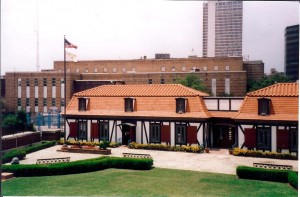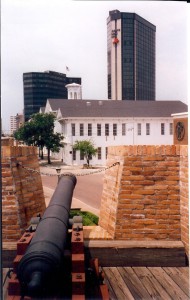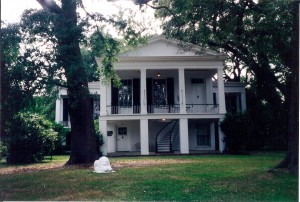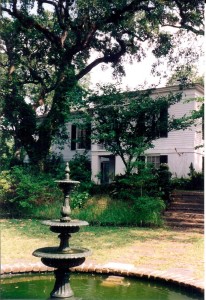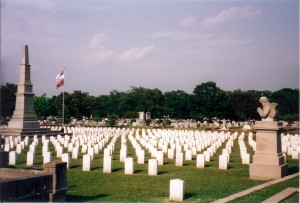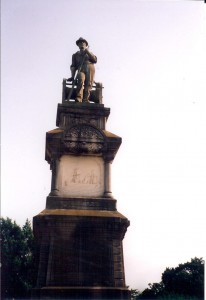One of the great dilemmas of this pilgrimage was becoming clear at this point in the trip. My eagerness to see all that the country has to offer was in direct conflict with my need to keep vacation as a time of relaxation and, consequently, the use of the alarm clock was largely banned. So, on this day, I woke first and headed to the pool to lap, despite our ambitious plans for Mobile. The day began overcast, and the Gulf was choppier. We had enjoyed good luck the day before, as our day at the beach was a lovely and sunny one. I strolled back across the beach to my room and, although I knew it was the right plan to head away from the sand and water, I did not feel ready to give it up. I picked up a large shell to remember it all, and headed for the shower.
We drove for Mobile, improvising hot tea again in a fast food restaurant and eating yogurt in the car. Eventually, we made our way to Fort Condé, where the welcome was warm.
The fort was outstanding, possibly the best educational display we had encountered so far. The history included the diversity of voices that are part of coastal history, including an honest discussion of slavery and segregation and the African-American experience. There were also captivating photos of Mardi Gras kings and queens from Mobile’s past, and costuming on display, a treat for me. We spent a long time there, with the brick of the fort protecting us from the heat of the day. At some point, guides dressed in colonial costuming returned from lunch. Since both were African-American, my companion and I discussed the issue that race plays in hiring for such museum positions. Do you staff black employees only in slave roles? Or do you sacrifice historical accuracy for fairness in hiring? We did not have an answer. The two staffers appeared to be dressed as Freedmen, possibly a helpful compromise on the part of the museum.
I have to admit that it was a relief to finally encounter some of Alabama’s history that pre-dated the Civil War, Reconstruction, and Civil Rights. Of course, the colonial historic narrative could not escape the influence of slavery on Mobile, but it was good to be historically outside of the Confederacy for a bit, back in a wider story of America as a whole. We both got more excited for Mobile at that point. The sun had come out, but the heat was not oppressive despite the humidity. I was grateful to be there during May and not August.
In addition to Fort Condé, there was an abundant supply of antebellum homes to explore. We headed to Oakleigh, an old mansion, where our tour guide (a student at the University of Alabama) was dressed to resemble Scarlett O’Hara at the opening of Gone with the Wind.
She was an effective guide, offering details about the house and wisecracking about the role of white women in 1840’s Mobile, which was the era the house décor aimed to evoke. We were joined by a group of Southern women and, as we stood in one room and discussed the history, they seemed to grow increasingly uncomfortable with our Northernness as we moved from the antebellum period to the Civil War itself. When our paths diverged, the guide continued her discussion of the war, emphasizing the role of northern sympathizers. I decided to ask her to put it in perspective, and she reaffirmed that Mobile was a committed part of the Confederate cause. Although she was generally disparaging about how women of leisure conducted their lives in the antebellum period, she assured us that her costuming was not uncomfortable or difficult. She did not address the experience of slave women at all.
The house was interesting and well preserved. The kitchen, in particular, was well stocked with 19th century artifacts. But I have to admit that the absence of any kind of slave discussion at this point in the tour was particularly glaring and I began to lose my patience. The charm we first felt at Fort Condé was fading. We agreed that we had reached our limit with house tours unless we crossed the path of something particularly interesting, like a well-recommended plantation.
We drove around Mobile looking at the exteriors of the homes and searching in vain for an open cafe or restaurant. We resorted to $2 Whoppers at Burger King because we were starving at this point and wanted to see Magnolia Cemetery, which is on the National Register of Historic Places. Initially, we found ourselves in an 1820’s yellow fever cemetery, but eventually found our way to Magnolia, tracing our route back through Oakleigh and then an African-American section of the neighborhood. We assumed that the neighborhood was always structured in this way, as the big houses would have need for servant/slave accommodation nearby. We struggled to find the cemetery entrance, passing the discarded remains of a Mardi Gras float lying on its side outside the gates, as if it too had been left for burial there. I wish now I had a photo of it.
We finally entered. It was fairly isolated, and our only living companions were an African-American man walking his dog and a woman we had seen at the yellow fever cemetery who had also been looking for this one. We picked our way around in search of the Confederate graves, which we found in a very large field with striking statuary. As we climbed around taking photos, my companion pointed out that we had seen no Confederate flags so far in our trip to Alabama, save for the ones at cemeteries and the occasional back window car sticker.
The cemetery was vast, with a large Jewish section as well. We nearly got the car stuck in one row as we attempted to turn it around without knocking over the historic headstones.
I was struck in the midst of this how grateful I was to have my traveling companion with me, as the cemetery was daunting and I could not have managed it on my own. For both of us, Mobile represented a pinnacle of home tours and cemeteries, and we decided to spend less time on either from that point in the trip. Leaving the cemetery, we circled around Cathedral Square, passed the Old Depot, a striking structure that looked targeted for demolition instead of preservation.
From there, we drove to Demopolis, where we planned to stay for the night. It was a pleasant trip on back roads, and we made only our second stop for gasoline in the trip. We received a hospitable Southern welcome upon arrival, and settled in for the night. It had been a rich but exhausting day. Mobile may have earned a place as our favorite location in Alabama, but we remained open to what lay ahead.

